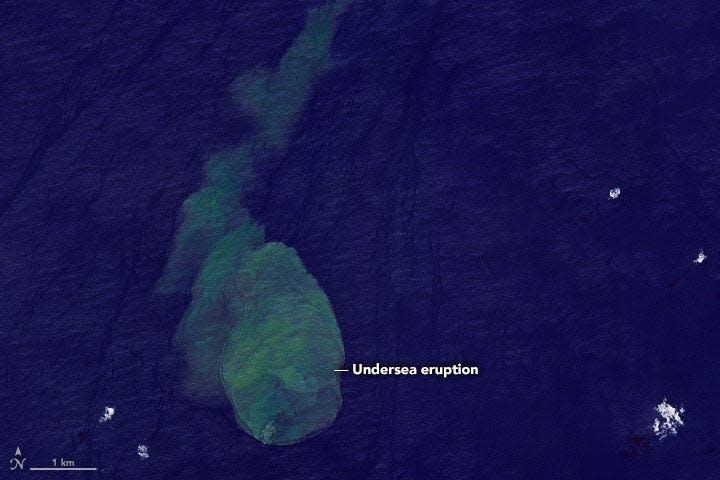NASA images reveal 'Sharkcano' eruption, where sharks live near active underwater volcano
An underwater volcano in the Pacific Ocean has begun to erupt, NASA images show. Living there: Sharks that can withstand extreme temperatures.
Off the coast of the Solomon Islands, about 950 northeast of Australia, exist Kavachi Volcano, one of the most active underwater volcanos in the Pacific. It's about 15 miles south of the Oceanic country's Vangunu Island. It's seafloor base is about 3,960 feet deep, and its summit is about 65 feet below sea level.
The Smithsonian Global Volcanism Program reported in November the volcano began to erupt in October and discoloration in water from the eruption could be seen by satellite data in April and May.
Satellite images taken by NASA's Operational Land Imager-2 on Landsat 9 on May 14 now prove the eruption, with volcanic plume from underwater, visible on the ocean's surface. NASA said the volcano is known to have explosive eruptions caused by the interaction of magma and water.

'Dragon of Death': Ancient fossils of gigantic flying reptile unearthed in Argentina
Move over TobyKeith: Pebbles the Toy Fox Terrier named world's oldest living dog at 22
However, what makes this volcano unique are the creatures that call it home. Kavachi Volcano has also been dubbed "Sharkcano" because in 2015, when the volcano was in a lull period of activity, an expedition to the area found there were two kinds of sharks, including hammerhead sharks, living near the crater. This came after a 2008 study found the volcano was constantly spewing volcanic particles and fragments into the water, making the environment acidic and "superheated," with temperatures reaching 100 degrees Fahrenheit.
Other fish were also found living around the volcano.
"Populations of gelatinous animals, small fish, and sharks were observed inside the active crater, raising new questions about the ecology of active submarine volcanoes and the extreme environments in which large marine animals can exist," the Oceanography article published in 2016 reads.
The constant eruption of the volcano, which has been recorded since 1939, has resulted in islands being created nearby, but NASA says they've been eroded and washed away by ocean waves. Large eruption have been reported in 2007 and 2014, NASA said, when residents on nearby islands could seen steam and ash.
Follow Jordan Mendoza on Twitter: @jordan_mendoza5.
This article originally appeared on USA TODAY: Underwater eruption of 'Sharkcano' captured by NASA satellites


